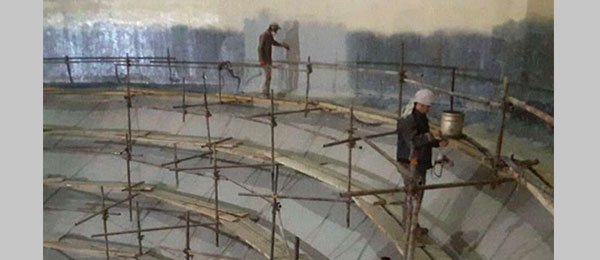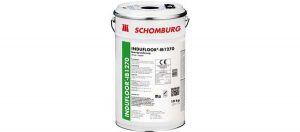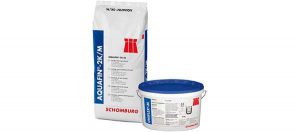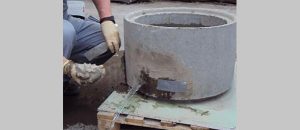ASODUR®-SG3 INDUFLOOR®-IB1250 Art.-No. 2 05049
Moisture blocking two-component epoxy primer
• solvent free
• two-component
• low viscosity
•VOC free
•moisture blocking
•water vapour impermeable
•water and frost resistant
• resistant to dilute alkalis, acids, water-based salt solutions and lubricants
Areas of application
ASODUR-SG3 is used:
•as a moisture barrier primer on cement-based surfaces
•as a primer on ceramic finishes, multi-layer wooden boards and similar, which are to be coated with ASODUR systems
• for producing levelling compounds and scratch coats
• for preparing substrates beneath conventional floor finishes such as PVC, Linoleum, carpet and others
Technical Data:
Basis: two-component epoxy resin
Colour: transparent
Viscosity*: approx. 600 ± ۸۰ mPA/s at +25 °C
Density*: approx. 1.09 g/cm3
Mixing ratio: 100:52 parts by weight Ambient and
substrate temp: min- +10 °C max. +35 °C at max. 80% rel. humidity
Pot life*: approx. 35 mins
Foot traffic after*: min. approx. 12 hrs Ready for
overcoating*: after approx. 12 hrs, max. 5 days
Fully cured*: after approx. 7 days
Tensile adhesion
strength: ≥ ۱.۵ N/mm2 Water vapour
permeability: SD > 50 m (Class III according to EN 1504-2) * The values refer to 23°C and 50% relative humidity.
Cleaning: Thoroughly clean tools immediately after use with ASO-R001.
Packaging: 1 kg, 3 kg, 10 kg and 30 kg container Components A and B are delivered at a predetermined mixing ratio.
Storage: frost-free, cool and dry, 24 months when stored in the original unopened containers, ≥ +۱۰ °C to +25 °C. Use opened containers promptly.
Substrate preparation
The areas to be treated must be:
•Dry or damp (in accordance with DAfStB RiLi SIB*), solid, load-bearing and have a good key.
• Free from separating and adhesion reducing substances such as e.g. dust, laitance, grease, rubber marks, paint residues and similar.Furthermore, ASODUR-SG2-thix can also be used on the following substrates:
•Concrete and cement-based screed areas subjected to reverse moisture penetration
•Concrete and cement-based screed areas with increased residual moisture* *) “Guidelines for the protection and repair of concrete sections”, part 2, section 2.3.5 “Concrete moisture”, ۰۷.۲۰۰۲.
Prepare substrates with reference to DIN EN 14879-1:2005, 4.2 following. Dependent on the condition of the substrate to be treated, use suitable mechanical preparation methods, e.g. high pressure water blasting, scabbling, shot blasting, planing etc, with which a textured, open surface is achieved. (Repair voids and cracks beforehand with a suitable product from the SCHOMBURG range).
Oil contaminated concrete:
• Following the preparation of the substrate, treat the affected area with the cleaning agent ASO-R008 (diluted in accordance with the technical data sheet for
ASO-R008).
•Clean the treated area with warm water (approx. +50°C to +70°C).
•Remove excess water with a suitable vacuum.
•Apply ASODUR-SG2-thix immediately to the surface whilst it is still damp, working in with a brush and finishing evenly with a paint roller.
Please note: No completely closed water film must be present on the surface of the concrete. The substrate may not dry out – with drying there is a risk that the oil will rise again and thus no bond will be achieved between the special primer and the substrate.
Appropriate to each particular substrate, the following criteria are also to be fulfilled:
Concrete quality: min. C 20/25
Screed quality: min. EN 13813 CT-C25-F6
Tensile adhesion strength: >1.5 N/mm2
Product preparation:
Components A (resin) and B (hardener) are delivered at a predetermined mixing ratio. Tip component B into component A. Ensure that the hardener drains completely from its container. Mix both components together using a suitable rotary stirrer at approx. 300 rpm (e.g. mixing paddle and drill). It is important that stirring agitates the sides and bottom so as to equally disperse the hardener. Stirring is to be continued until the mix is homogenous (free from streaks): mix time 3 minutes. During the mixing process the temperature should be approx. +15 °C. Do not use mixed material directly from the packaging! Decant the mixture into a clean mixing bucket and thoroughly stir through once again.
Note:
When applying the product please ensure that the material is evenly “flooded” over the prepared substrate. Uneven areas lead to capillary pores in the hardened priming coat, which benefits the formation of bubbles, especially osmosis bubbles. To ensure a pore free priming coat, apply the primer in two coats “wet in wet”. The pore-free finish can be enhanced by the application of a second coat of a watertight smoothing mortar. This smoothing mortar is to be produced from the priming resin with the addition of quartz sand – see production: levelling/key coat.When mixing aggregate (e.g. quartz sand) it must be ensured that the aggregate is dry and is also at +15 °C. Production of levelling/key coats: ASODUR-SG3: 1.0 part by weight
Quartz sand: approx. 1.0 part by weight (particle size 0.1 – 0.6 mm)
Fibre filler ASO-FF: approx. 2–۳ % by weight The quartz sand is to be added to the previously mixed and decanted resin and hardener components. Ensure
that the liquid and solid components are evenly dispersed.
Method of application / consumption:
Priming: ASODUR-SG3 is flood applied in one application to fill the pores. Consumption: approx. 400–۷۰۰ g/m²
Advice:
•Overcoat the clean, primed area within 12 hrs to max. 5 days.
• Primer not ‘broadcast’ with quartz sand may only be walked on with clean “overshoes”. “Broadcasting” a second coat of primer with quartz sand is possible (grain size: e.g. 0.1–۰.۶ mm). Consumption: approx. 0.8–۱.۰ kg/m² Once hardened, thoroughly remove all non-bound quartz before installing a roller applied or self-levelling coating / scratch coat or screed.Levelling layer/scratch coat: Firstly prime the substrate with ASODUR-SG3. The mixed smoothing mortar is applied in one operation using scratch coating techniques.
Consumption of finished smoothing mortar: approx. 1,600 g/m² per mm thickness
Important advice:
•As a rule, SCHOMBURG products are supplied in working packs i.e. at a mix ratio matched together. When supplied in large containers, part quantities must be weighed out using a balance. Always thoroughly stir the filled components and only then mix with the second component. This is to be executed with a suitable stirrer e.g. Polyplan/Ronden mixing paddle or similar. In order to exclude mixing errors, decant into a clean container and mix anew. The mixing speed should be approx. 300 rpm. Ensure that no air is mixed in. The temperature of the components should be minimum +15°C. This is also valid for any potential fillers to be mixed, e.g. sands. The addition of the fillers is only to occur once both liquid components have been blended. Afterwards place the completely mixed material immediately on to the prepared substrate and quickly and carefully spread out in accordance with the instructions in the technical data sheet. For applications by roller, it is recommended to use a short nap nylon paint roller (6 mm) with a textured polyamide cover or
similar. Always thoroughly stir one component products before use.
•Higher temperatures shorten the pot life. Lower temperatures increase the pot life and setting time. Material consumption is also increased at lower temperatures.
•Colours: Small variations in colour, resulting from varying production batches and raw material fluctuations, are unavoidable. When applying coatings, take this into consideration. Carry out neighbouring sections with the same production batch (same batch number on the packaging).
• The bond between individual coats can be heavily impeded by the penetration of moisture and contamination between the individual coats. Coating work requires a substrate temperature of at least 3°C above the dew point temperature.
• If there is a long down time between individual coats or if already treated areas are to be renewed with liquid resins after a long period of time, then the old surface is to be well cleaned and thoroughly abraded.Afterwards carry out a completely new pinhole free coating.
•Surface protection systems must be protected from moisture (e.g. rain, melt water) after their application for approx. 4–۶ hours. Moisture produces a white discolouration and/or stickiness on the surface and can lead to interference in the curing process. Take off discoloured and/or sticky surfaces by e.g. planing or abrasive blast techniques and renew.
•Consumption quantities given are values determined by calculation without additions for surface roughness or absorption, levelling or residues in the containers. We recommend adding a calculated safety factor of 10% to the computed consumption quantities.
•Applications, which are not clearly mentioned in this technical data sheet may only be implemented after consultation with and written confirmation from the technical service department of SCHOMBURG.
•Cured product residues can be disposed of using waste disposal code AVV 150106. Please observe a valid EU safety data sheet!
GISCODE: RE 1




